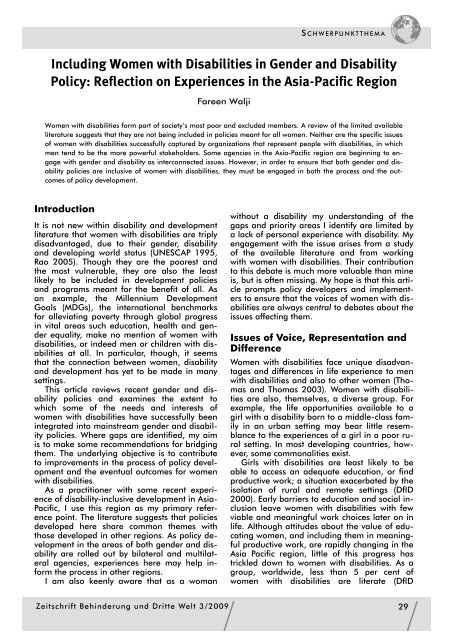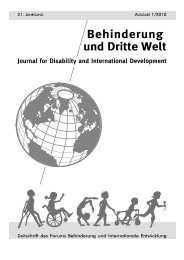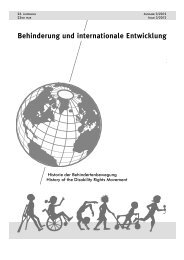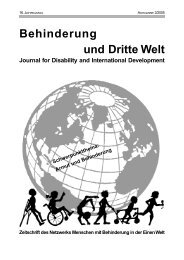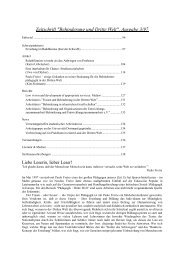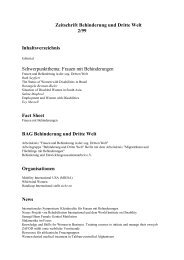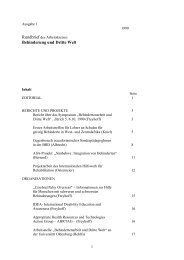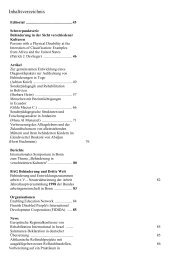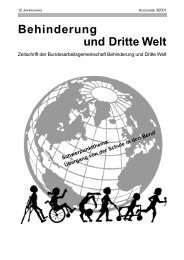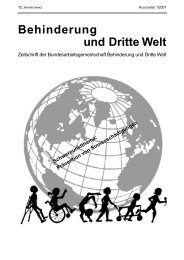Zeitschrift Behinderung und Dritte Welt
Zeitschrift Behinderung und Dritte Welt
Zeitschrift Behinderung und Dritte Welt
You also want an ePaper? Increase the reach of your titles
YUMPU automatically turns print PDFs into web optimized ePapers that Google loves.
S CHWERPUNKTTHEMAIncluding Women with Disabilities in Gender and DisabilityPolicy: Reflection on Experiences in the Asia-Pacific RegionFareen WaljiWomen with disabilities form part of society’s most poor and excluded members. A review of the limited availableliterature suggests that they are not being included in policies meant for all women. Neither are the specific issuesof women with disabilities successfully captured by organizations that represent people with disabilities, in whichmen tend to be the more powerful stakeholders. Some agencies in the Asia-Pacific region are beginning to engagewith gender and disability as interconnected issues. However, in order to ensure that both gender and disabilitypolicies are inclusive of women with disabilities, they must be engaged in both the process and the outcomesof policy development.IntroductionIt is not new within disability and developmentliterature that women with disabilities are triplydisadvantaged, due to their gender, disabilityand developing world status (UNESCAP 1995,Rao 2005). Though they are the poorest andthe most vulnerable, they are also the leastlikely to be included in development policiesand programs meant for the benefit of all. Asan example, the Millennium DevelopmentGoals (MDGs), the international benchmarksfor alleviating poverty through global progressin vital areas such education, health and genderequality, make no mention of women withdisabilities, or indeed men or children with disabilitiesat all. In particular, though, it seemsthat the connection between women, disabilityand development has yet to be made in manysettings.This article reviews recent gender and disabilitypolicies and examines the extent towhich some of the needs and interests ofwomen with disabilities have successfully beenintegrated into mainstream gender and disabilitypolicies. Where gaps are identified, my aimis to make some recommendations for bridgingthem. The <strong>und</strong>erlying objective is to contributeto improvements in the process of policy developmentand the eventual outcomes for womenwith disabilities.As a practitioner with some recent experienceof disability-inclusive development in Asia-Pacific, I use this region as my primary referencepoint. The literature suggests that policiesdeveloped here share common themes withthose developed in other regions. As policy developmentin the areas of both gender and disabilityare rolled out by bilateral and multilateralagencies, experiences here may help informthe process in other regions.I am also keenly aware that as a womanwithout a disability my <strong>und</strong>erstanding of thegaps and priority areas I identify are limited bya lack of personal experience with disability. Myengagement with the issue arises from a studyof the available literature and from workingwith women with disabilities. Their contributionto this debate is much more valuable than mineis, but is often missing. My hope is that this articleprompts policy developers and implementersto ensure that the voices of women with disabilitiesare always central to debates about theissues affecting them.Issues of Voice, Representation andDifferenceWomen with disabilities face unique disadvantagesand differences in life experience to menwith disabilities and also to other women (Thomasand Thomas 2003). Women with disabilitiesare also, themselves, a diverse group. Forexample, the life opportunities available to agirl with a disability born to a middle-class familyin an urban setting may bear little resemblanceto the experiences of a girl in a poor ruralsetting. In most developing countries, however,some commonalities exist.Girls with disabilities are least likely to beable to access an adequate education, or findproductive work; a situation exacerbated by theisolation of rural and remote settings (DfID2000). Early barriers to education and social inclusionleave women with disabilities with fewviable and meaningful work choices later on inlife. Although attitudes about the value of educatingwomen, and including them in meaningfulproductive work, are rapidly changing in theAsia Pacific region, little of this progress hastrickled down to women with disabilities. As agroup, worldwide, less than 5 per cent ofwomen with disabilities are literate (DfID<strong>Zeitschrift</strong> <strong>Behinderung</strong> <strong>und</strong> <strong>Dritte</strong> <strong>Welt</strong> 3/200929


